Mustang Coveralls
With regard to your recently re-posted report “Cold Water Survival” (see Practical Sailor, March 2019), I bought a Mustang Anti-Exposure Coverall many years ago. I have worn it when sailing and fishing on Lake Erie, Lake Ontario, the Niagara River, the Atlantic Ocean, and the Gulf of Mexico. I wear it when the water temperature is below 68 degrees F or in situations where we will be sailing or fishing with the air temperature below 60 degrees F. The Coverall has reflective strips, insulation, a hood, and an inflatable pillow to keep your head out of the water. It is colored orange. In my experience it is it warm and comfortable to wear in cold situations. A negative is that it is bulky to store and costs around $475. I add an inflatable life jacket with a built-in harness and a light and whistle. I have worn it about 200 days. I give it five stars out of five.
Mark Corson
Moya-Manzi, Beneteau 31
Cleveland, OH
Schenker Watermaker
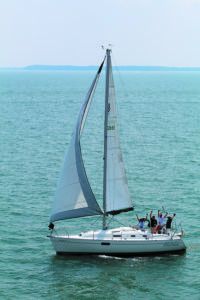
Bass Island on Lake Erie. They boat’s name means
wind-water in his Zulu.
I enjoyed reading your post about the Schenker watermaker. My wife and I can gladly attest to the usefulness and efficiency of the model Zen 30 I installed last year aboard our Pretorien 35. Being tight for space, we actually removed one of our two 35-gallon tanks, to make room for the system. And so glad we did. Throughout cruising the Atlantic coast, then to Bermuda, Antigua and many other islands last winter, we eventually found ourselves quarantined in Culebra for two months before returning to New England in June. But we never once had to acquire water elsewhere. Always testing to under 250 total dissolved solids (TDS), and making 7 to 8 gallons per hour, and using less than 9A @12V, this little machine is one we can’t consider doing without. For almost 14 months, we made water every 2-3 days, using solar power, and drank the water always straight from the tank. Now in the process of buying another boat, this unit will be the first upgrade on the list before setting out again!
Chris & Kelly Jacques
Fayaway, Waquiez Pretorien
Newburyport, MA
Anyone interested in ensuring they have clean, fresh water on their boat wherever they roam, with or without a watermaker, should consider our ground-breaking report on onboard water quality, “Onboard Water Treatment, Storage, and Production” (see www.practical-sailor.com/product/onboard-water-treatment-storage-and-production-complete-series) The four-volume series covers rain catchers, watermakers, water testing, water treatment, water filtration, collapsible and polyethylene water tanks, decontaminating water tanks, repairing water tanks, and much more. Without doubt, this is most comprehensive survey of gear and methods to ensure sailors can safely meet one of their most basic needs—clean drinking water.
Overboard Ready
It’s not just ‘rough’ conditions that are increase the risk of losing a person overboard. In light weather, many take more risks. I carry a cylume torch, wrapped in an orange flag with cord to tie around one’s neck and fit over your wrist for waving, so it can’t be washed or blown away, inside a rigid tube (so it doesn’t break accidentally), and also wear an orange or air sea rescue colored hat, as you loose 1/3 of your body heat through your head, and that’s the most likely way to be seen. A mirror can be aimed through your fingers, from the sun, searchlight, or moon? I tow two lines attached to the tillers, and a block ‘n’ tackle, in case you can get back to the boat.
James Vayro
Dragonfly 35
Queensland, Australia
With winter upon us, and boats sitting on the hard in many places, it’s a good time to troubleshoot or update systems, and to make a to-do list for the off-season and pre-season.
Stay Up to Date
It’s never a bad time to update the software for your onboard electronics, but before you do, be sure to read the “Pain-free Marine Electronics Update” blog post (Inside Practical Sailor, March 31, 2015), as well as the May 2015 article, “Playing with Cards,” an extensive look at which digital-media storage cards are compatible with various marine electronics.

Dry Storage
Looking for ways to keep your cabin dry during off-season storage, and to prevent that musty, mildew smell? There are a number of de-humidifying methods and products available, but good ventilation is the most effective. Other options include electric dehumidifiers (PS June 2013) and absorbent chemicals, or desiccants (PS November 2012). Testers evaluated anti-mildew protectants in the November 2013 issue and mold-inhibiting products in June 2010, as well as commercial mold-cleaning products in the January 2009 issue.
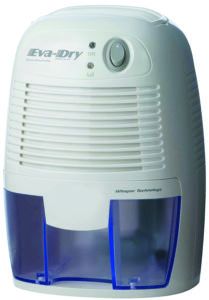
Boat Stink
If you’re battling boat stink of the holding-tank variety, be sure to read our tips for stopping stink in the May 21, 2015 blog post, along with the many sanitation system product tests we’ve done in recent years. The December 2013 issue offers a 30-month update on sanitation hose and holding-tank vent filter tests; we reviewed holding tank treatments in the February 2012 issue; and offered advice on cleaning holding tanks in the November 2015 PS Advisor. You’ll find some of these articles and other useful info in our Marine Sanitation ebook series, which is available at www.practical-sailor.com/books
Gift Shopping
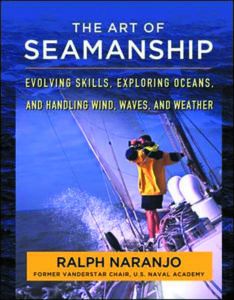
Did those holiday gifts fall flat? A do-over is easy at PS online. Be sure to browse through our past Chandlery articles, which highlight new and innovative sailing gear. If you’re short on time, check out our online bookstore,www.practical-sailor.com/books, where you can select from the dozens of sailing resources that PS editors recommend, as well as Practical Sailor’s ebooks and subscription products.
Mildew Dilemma
Mildew is a huge problem in Tampa Bay, where the air is often still and dirty. I’m fighting it with a little dehumidifier inside and keeping much of the boat covered and out of the sun and rain. I think mildew likes the sun. Don’t green things grow in the sun? I’ve settled on scrubbing with equal parts vinegar, Simple Green and water, but then rubber and Lexan aren’t on my deck for vinegar to damage. Mildew isn’t the worst of it. There’s mold in the teak on deck, for which there is no cure. Since mold doesn’t really harm wood, I’ve been sealing it with epoxy and then painting it, hoping the mold won’t shine through eventually. So far so good.
Sue Haynie
via Practical-sailor.com
If you are talking about exterior teak in Tampa, it is probably algae. Algae likes the sun, mildew likes the dark. We published an article on cleaning teak (see PS April 2016, “Spiffy Teak Tips”), which included mildew. Borax is one of the least damaging cleaners for teak. For killing algae, a light spray of Wet-and-Forget will also do a fine job. Follow the directions, followed by a scrubbing a week later. Never scrub teak with the grain, you will pull out all the soft wood and leave deep grooves. Vinegar is also a good product for removing water spots, and will not damage Lexan and is a good product for removing water spots.
Mold will eat any wood, it just eats teak more slowly. According to Swedish boatbuilder Hallberg Rassy, whose boats are replete with teak, the best cure for mold in teak is Boracol, which is a glycol/borax blend that is allowed to soak into the teak (see this month’s article, “Treating Teak Decks,” page 20). Treat once per year, or more often if desired. I’ve been testing this product for almost 20 years, though I have not reported on it.
Micron 66 Mystery
We applied two coats of Micron 66 purchased in Panama in about May 2019, over a previous coat of the same paint. We could not get enough blue so we used black on the lower half. We then transited the Panama Canal and crossed the first half of the Pacific in July/August. After a few weeks in the Tuamotus with little growth (normal there) we went to the Marquesas and stayed for a couple of months in Taiohea Bay, Nuku Hiva, a very bioactive location. The adjacent image is what we found when I dove on the hull. This was taken about seven months after putting the paint on. I sent this to Interlux tech support but it remains unexplained although they suggested the black might have been old stock.
Next time you do an antifouling report you should put a warning on Micron 66 (and perhaps others). This paint cannot be taken into fresh water at all. Not only does it not work but it apparently can severely compromise the paint on return to salt water. Their tech support were sufficiently concerned that they told me I should not transit the Panama Canal with it. This could be a serious issue for many coastal sailors. We will certainly not use it again.
Graham Openshaw
Leela, Bristol 38.8
Portsmouth,NH
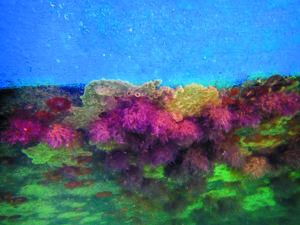
Our reports on Micron 66 should already include the freshwater caveat. As we understand, the Panama Canal transit is too brief to ruin the paint’s effectiveness, but we are following up with Interlux. As for the effectiveness of black paint over blue paint—we’ve never seen a difference as striking as yours. We have found no conclusive evidence that color impacts performance, although we do get a surprising number of black paints submitted for testing. One supplier said that they sent black paint under the belief that black conceals the appearance of soft growth—which would result in a slightly better rating. Our testers are saavy to this tactic. The difference in the photo you send is striking, and suggests a problem with the black paint. This is a good reminder to take photos of your bottom paint can (including lot number), and keep all receipts. In clear-cut cases like this, the manufacturer will often provide paint for your next haulout.
We have tested eco-friendly paints that are better suited for freshwater (see Practical Sailor April 2018 “Freshwater Bottom Paints”).
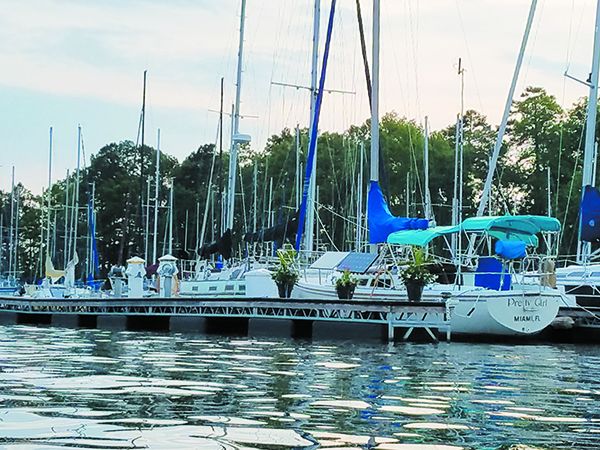
An Inland Tropical Storm
We live in the Atlanta GA area and sail on Lake Lanier. TS Zeta came through here with gusts into the high 60 mph. Originally the storm was only forecast to be 20 mph gusting to the 30s, so I did not make the drive to add extra lines. A few dock mates stayed on their boats but I don’t know that they would have if they knew how much higher the winds would be. The storm was so intense waves were coming over the floating docks in the marina and it was quite a ride for those that stayed. Our boat is in the last slip, the first to take the wind and waves. We had a 0.5” bow line part after the 0.125” dyneema line that attached a shockle to it parted. (4500# breaking strength!) Our solar panels flipped off their mounts, but were surprisingly not damaged.
Chris Wolcott
Pretty Girl, Catalina 30
Lake Lanier, Georgia
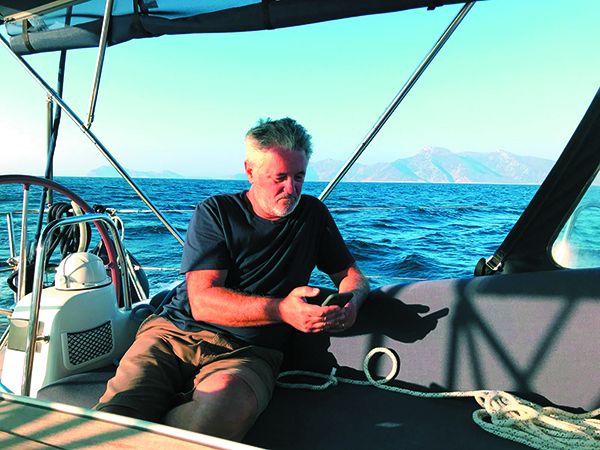
Thanks for your letter. Powerful summer squalls are common on Lake Lanier, and your current setup might be sufficient for those. However, for the longer lasting tropical storms you’ll want to consider making adjustments. Elastic snubbers like shockles will become ineffective as wave action increases and winds exceed 25 knots. We found one of the best things you can do to preserve your dock lines and deck hardware—apart from the usual advice of chafe gear, etc.—is to arrange docklines, especially spring lines, so that they are as long as possible. This maximizes the amount of stretch in each line. By taking advantage of each line’s inherent elasticity, you can keep loads well below each line’s rated maximum (see “Spring Lines For Storm Preparedness,” PS July 2016 and the Inside Practical Sailor blog post, “Preparing a Marina-bound Boat for a Storm”).
Audio Expert Chimes In
Another option for reducing engine noise would be to add more insulation material to the outside of the engine enclosure (see Inside Practical Sailor blog post “Reducing Engine Room Noise”). A couple inches inside, a hard layer (fiberglass enclosure), and then two more inches outside where possible should more than double the attenuation at those areas. That sound that does escape to the cabin may actually increase in volume as it reflects around the cabin interior, so more insulation could be added there if desired, especially in any corners, as we do treating interiors of recording studios.
Those low rumbling frequencies won’t bounce too much as they’ll pass right through the boat. But a “standing wave” between 125 and 250 hz can bounce enough to actually increase in volume after leaving the engine space. Corner absorbers are sold often for such purposes, and homemade solutions abound.
Pat McAtee
McAtee Audio and Video
Raymore, MO
Rock Wool Insulation?
With regards to your recent blog post on engine room noise (see Inside Practical Sailor blog post “Reducing Engine Room Noise”), please consider rock wool insulation. Unlike lead, it isn’t toxic. Unlike foam, it won’t burn. And unlike fiberglass, it won’t melt. It’s cheap and can be purchased at most home improvement stores
Patrick Bryant
Pearson Ariel
Half Moon Bay, CA
Vinegar in the head
Regarding your recent re-post on descaling formulas (see Practical Sailor August 2017 “Descaling Solutions for Boats”), the secret to vinegar is twofold:
1) It only works well in fresh water.
2) The water needs to be warm.
Start by flushing the head through a few times with sweet water, letting it sit a bit between flushes, then flush it as dry as you can. Then pour in 2 litres of warm water, max 50C (122F) that is 25-percent white vinegar and let that sit overnight if possible. Then flush with fresh water and do it again if necessary.
A little brush work while it’s working helps the process.
The same mixture does wonders on your water speed wheel in the depth sounder to clear the life that forms there. All cheap, effective and eco-friendly.
Olivier Vetter
Beneteau Oceanis 40
Cesme, Turkey
Patience is indeed the key to using vinegar. As our report noted, vinegar also removed the most amount of material from our steel coupons used for our test. Other more effective acids in our test were effectively harmless to the marine environment, but it’s hard to get more eco-friendly than organically grown vinegar.
Clarification
Unfortunately, Diadora has discontinued its keeper pants featured in the November 2020 article, “Kicking Back in Keeper Pants.” The online version of the report offers some alternatives, including keeper pants from Adidas. Along with Adidas (our current recommendation), Storelli, Reusch, and Kelme are brands that have the features our testers liked.





























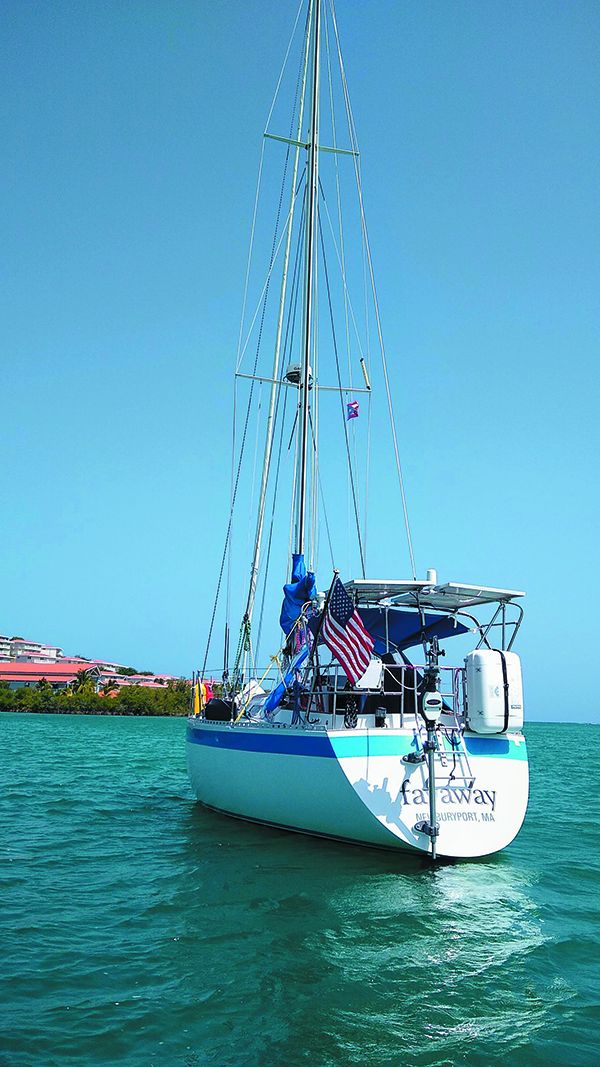





I have a 35 year old S2 sailboat with fresh water supply going to several sinks. The water feed lines are a transparent flexible plastic line and they have become “black” on the interior over the years. I’m a bit reluctant to try to replace them since they “snake” their way under the floor and the floor is not removable. So, pulling new lines through by attaching the new to the old might be a solution but – again – I’d hate for the connection to break in the middle since the floor is not removable and the lines snake through the floor.
Is there a way to clean these lines to remove the black (apparently algae)?
It’s an aesthetic issue, more than health….we rarely use the fresh water for drinking….just for “dishes.”
Don
don@equipintegration.com